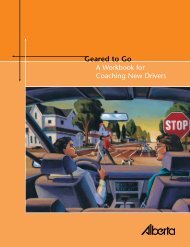Commercial driver's guide to operation, safety and licensing
Commercial driver's guide to operation, safety and licensing
Commercial driver's guide to operation, safety and licensing
You also want an ePaper? Increase the reach of your titles
YUMPU automatically turns print PDFs into web optimized ePapers that Google loves.
• Having w<strong>and</strong>ering, disconnected thoughts<br />
• Driving the past few kilometres without<br />
remembering them<br />
• Drifting between lanes, tailgating or<br />
missing traffic signs<br />
• Noticing a vehicle in the rear view mirror<br />
that seemed <strong>to</strong> appear out of nowhere<br />
Railway Crossing<br />
Most fatigue-related collisions happen<br />
between 1 - 4 p.m. <strong>and</strong> early in the<br />
morning between 2 - 6 a.m. Typically,<br />
fatigue-related collisions occur at higher<br />
speeds <strong>and</strong> can result in drivers running off<br />
the road or vehicles colliding head-on with<br />
other vehicles or stationary objects.<br />
How <strong>to</strong> reduce driver fatigue<br />
Turning up the radio, opening a window,<br />
drinking coffee, chewing gum or eating will<br />
help reduce driver fatigue for short periods<br />
of time but the following actions will help<br />
prevent driver fatigue:<br />
• Become aware of your own biological<br />
clock <strong>and</strong> avoid driving during your<br />
body’s down time.<br />
• S<strong>to</strong>p if you become sleepy while<br />
on the road.<br />
• Get plenty of sleep the night<br />
before a long trip.<br />
• Avoid working all day <strong>and</strong> then driving<br />
all night. Stay overnight rather than<br />
driving straight through.<br />
• Schedule a break every two hours or<br />
every 160 km. Stretch or take a walk <strong>to</strong><br />
get some fresh air.<br />
• Take a mid-afternoon break.<br />
Have a 20-40 minute nap.<br />
• Travel with an awake <strong>and</strong> alert passenger.<br />
Having someone <strong>to</strong> chat with will keep<br />
the driver awake <strong>and</strong> the passenger<br />
can also let the driver know if he/she is<br />
showing any signs of fatigue.<br />
Crossing railway tracks can be especially<br />
hazardous for drivers of large vehicles<br />
because of the following:<br />
• Longer vehicles need <strong>to</strong> travel further<br />
<strong>and</strong> will need more time <strong>to</strong> clear a<br />
crossing.<br />
• Heavier vehicles take more time <strong>and</strong><br />
need more room <strong>to</strong> s<strong>to</strong>p before a<br />
crossing.<br />
• Larger vehicles are more likely <strong>to</strong> derail<br />
a train if there is a collision.<br />
Suggested approach<br />
<strong>to</strong> s<strong>to</strong>pping<br />
• Slow down, shift <strong>to</strong> a lower gear if you<br />
have a manual transmission, <strong>and</strong> test<br />
your brakes.<br />
• Check for traffic behind you <strong>and</strong> then<br />
s<strong>to</strong>p gradually.<br />
• S<strong>to</strong>p no closer than five metres (about<br />
16 feet) <strong>and</strong> no further than 15 metres<br />
(about 49 feet) from the nearest rail.<br />
• To better hear a train, roll down the<br />
window <strong>and</strong> reduce any noise inside the<br />
vehicle.<br />
• While s<strong>to</strong>pped, look carefully in each<br />
direction for approaching trains. Look<br />
around obstructions such as mirrors<br />
<strong>and</strong> windshield pillars.<br />
• When waiting, put on your park brakes<br />
so that you will not move on<strong>to</strong> the track.<br />
84 A <strong>Commercial</strong> Driver’s Guide <strong>to</strong> Operation, Safety <strong>and</strong> Licensing




